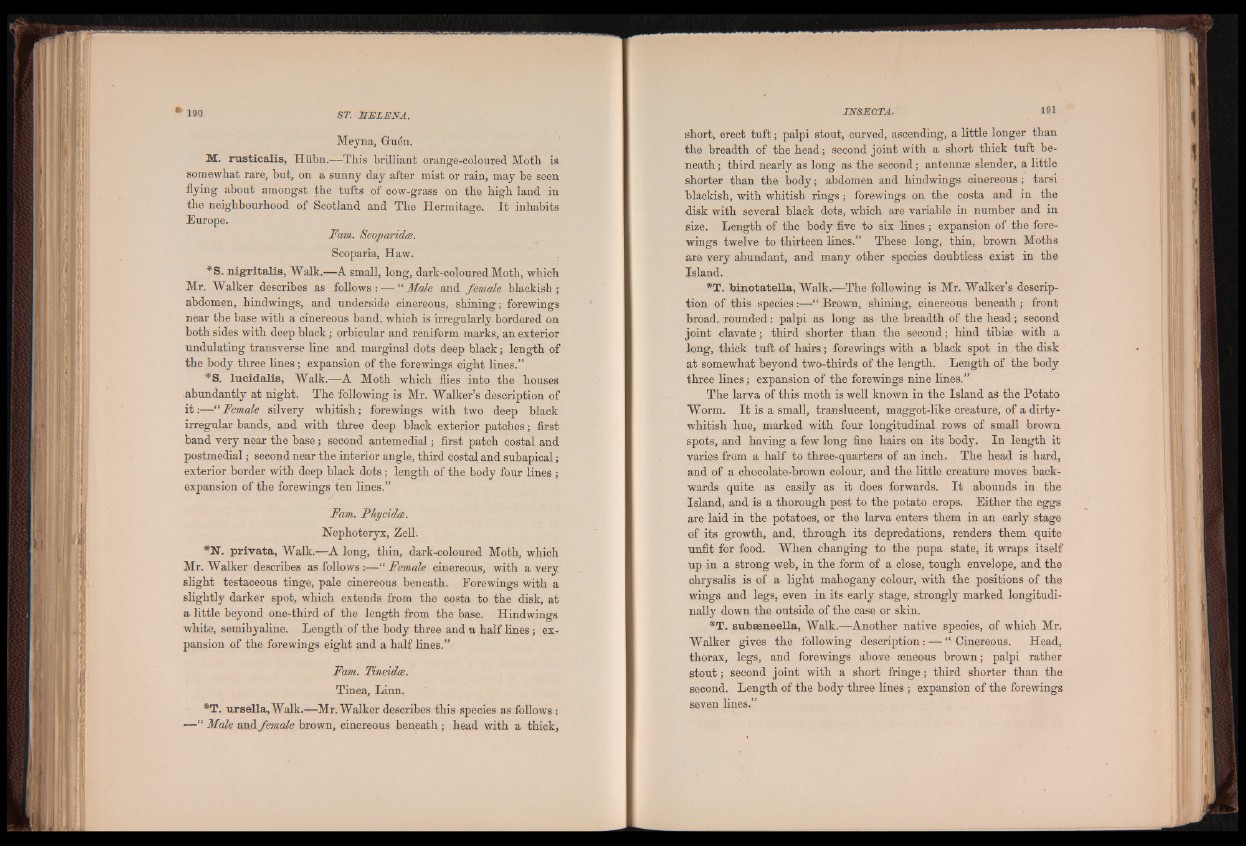
Meyna, Guén.
M. rusticalis, Hiibn.—This brilliant orange-coloured Moth is
somewhat rare, but, on a sunny day after mist or rain, may be seen
flying about amongst the tufts of cow-grass on the high land in
the neighbourhood of Scotland and The Hermitage. I t inhabits
Europe.
Fam. Scoparidce.
Scoparia, Haw.
*S. nig ritalis, Walk.—A. small, long, dark-coloured Moth, which
Mr. Walker describes as follows : Male and female blackish ;
abdomen, hindwings, and underside cinereous, shining; forewings
near the base with a cinereous band, which is irregularly bordered on
both sides with deep black; orbicular and reniform marks, an exterior
undulating transverse line and marginal dots deep black; length of
the body three lines; expansion of the forewings eight lines.”
*S. lucidalis, Walk.-BA Moth which flies into the houses
abundantly at night. The following is Mr. Walker’s description of
i t :—“ Female silvery whitish; forewings with two deep black
irregular bands, and with three deep black exterior patches; first
band very near the base; second antemedial; first patch costal and
postmedial; second near the interior angle, third costal and subapical;
exterior border with deep black dots; length of the body four lines ;
expansion of the forewings ten lines.”
Fam. Fhycidce.
Nephoteryx, Zell.
*N. p riv a ta , Walk.—A long, thin, dark-coloured Moth, which
Mr. Walker describes as follows :—“ Female cinereous, with a very
slight testaceous tinge, pale cinereous beneath. Forewings with a
slightly darker spot, which extends from the costa to the disk, at
a little beyond one-third of the length from the base. Hindwings
white, semihyaline. Length of the body three and a half lines; expansion
of the forewings eight and a half lines.”
Fam. lineidce.
Tinea, Linn.
*T. ursella,Walk.—Mr. Walker describes this species as follows ;
—“ Male and female brown, cinereous beneath; head with a thick,
short, erect tu f t; palpi stout, curved, ascending, a little longer than
the breadth of the head; second joint with a short thick tuft beneath
; third nearly as long as the second; antennae slender, a little
shorter than the body; abdomen and hindwings cinereous; tarsi
blackish, with whitish rin g s; fore wings on the costa and in the
disk with several black dots, which are variable in number and in
size. Length of the body five to six lines; expansion of the forewings
twelve to thirteen lines.” These long, thin, brown Moths
are very abundant, and many other species doubtless exist in the
Island.
* T . b in o t a t e l l a , Walk.—The following is Mr. Walker’s description
of this species :— “ Brown, shining, cinereous beneath ; front
broad, rounded; palpi as long as the breadth of the head; second
joint clavate; third shorter than the second; hind tibiae with a
long, thick tuft of hairs; forewings with a black spot in the disk
at somewhat beyond two-thirds of the length. Length of the body
three lines; expansion of the forewings nine lines.”
The larva of this moth is well known in the Island as the Potato
Worm. I t is a small, translucent, maggot-like creature, of a dirty-
whitish hue, marked with four longitudinal rows of small brown
spots, and having a few long fine hairs on its body. In length it
varies from a half to three-quarters of an inch. The head is hard,
and of a chocolate-brown colour, and the little creature moves backwards
quite as easily as it does forwards. I t abounds in the
Island, and is a thorough pest to the potato crops. Either the eggs
are laid in the potatoes, or the larva enters them in an early stage
of its growth, and, through its depredations, renders them quite
unfit for food. When changing to the pupa state, it wraps itself
up in a strong web, in the form of a close, tough envelope, and the
chrysalis is of a light mahogany colour, with the positions of the
wings and legs, even in its early stage, strongly marked longitudinally
down the outside of the case or skin.
*T . su b e e n e e l la , Walk.—Another native species, of which Mr.
Walker gives the following description:— “ Cinereous. Head,
thorax, legs, and forewings above seneous brown; palpi rather
s to u t; second joint with a short fringe; third shorter than the
second. Length of the body three lines; expansion of the forewings
seven lines.”